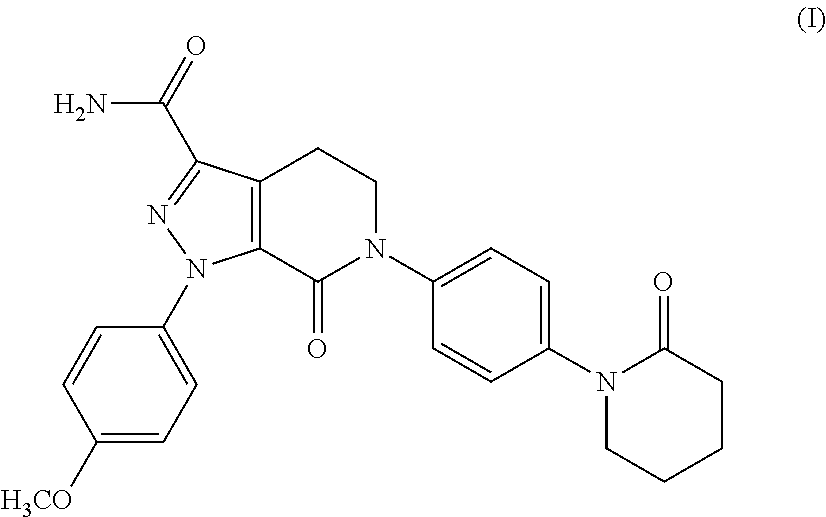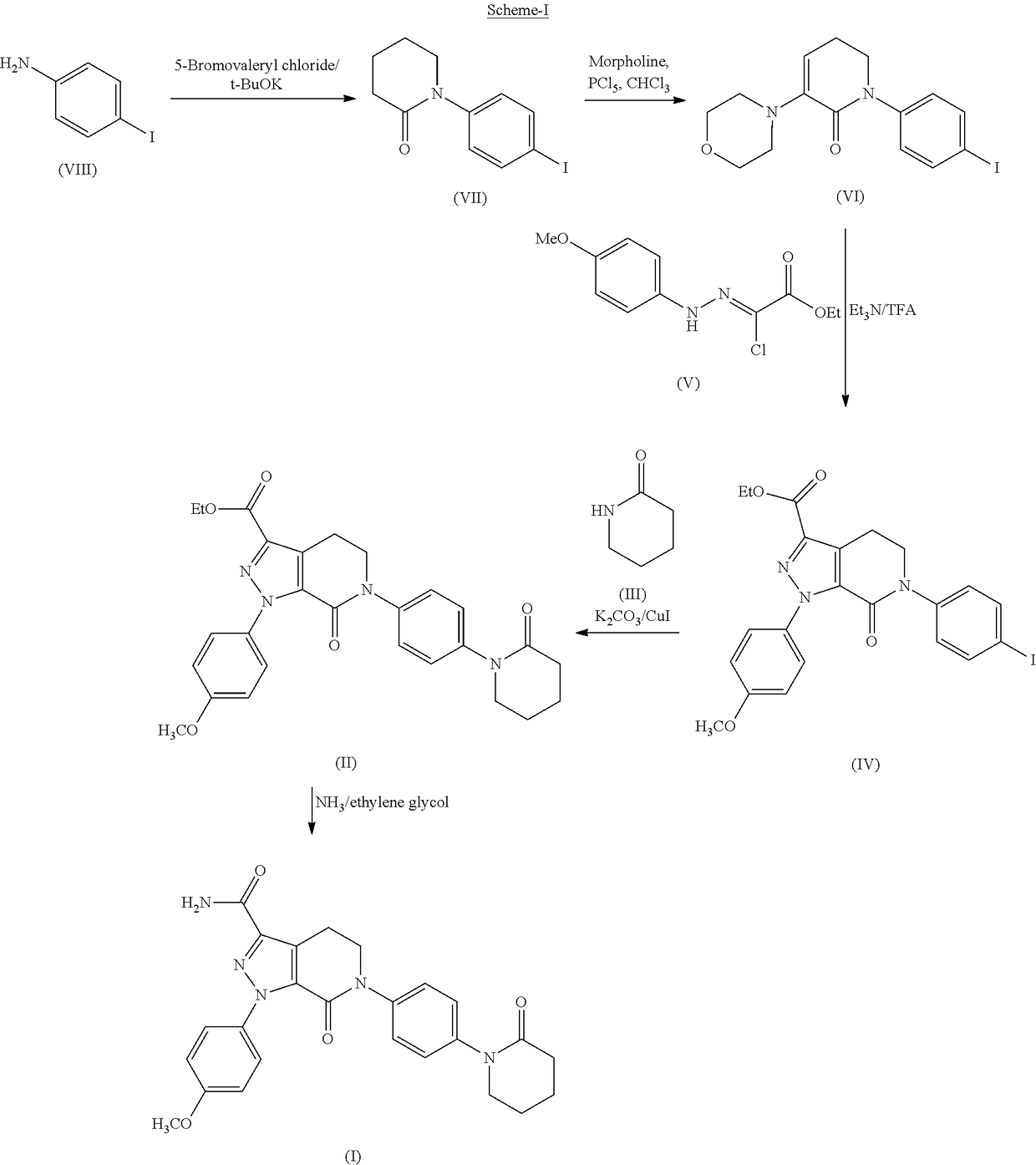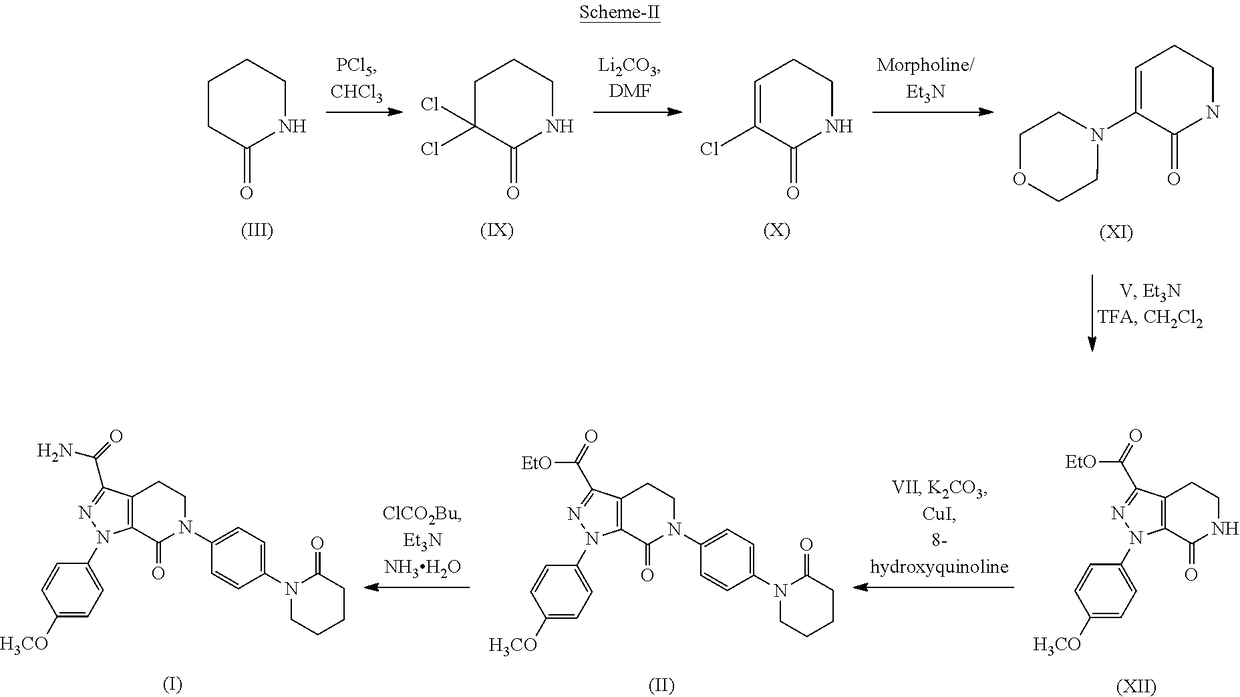Process for the preparation of apixaban
a technology of apixaban and apixaban, which is applied in the field of process for the preparation of apixaban, can solve the problems of high cost, corrosive/toxic reagents, and drastic reaction conditions
- Summary
- Abstract
- Description
- Claims
- Application Information
AI Technical Summary
Benefits of technology
Problems solved by technology
Method used
Image
Examples
example-1
Preparation of 5-bromo-pentanoic acid (4-iodo-phenyl)-amide
Method-A:
[0056]4-Iodoaniline (400 g, 1.826 moles), triethylamine (258 g, 2.557 moles) and dimethylamino pyridine (10 g) were dissolved in ethyl acetate (2000 ml) and cooled to 5 to 15° C. 5-Bromovaleryl chloride (474 g, 2.374 moles) dissolved in ethyl acetate (100 ml) was added dropwise to the reaction mixture over a period of 2.5-3 hrs at the same temperature. After completion of the reaction, the obtained solid was filtered, washed with water (1000 ml) and dried to get 530 g (76%) of the title compound.
Method-B:
[0057]4-Iodoaniline (40 g, 0.18 moles), triethylamine (25.8 g, 0.25 moles) and dimethylamino pyridine (1 g) were dissolved in methylene dichloride (200 ml) and cooled to 5 to 15° C. 5-Bromovaleryl chloride (47.4 g, 0.237 moles) dissolved in methylene dichloride (20 ml) was added dropwise to the reaction mixture over a period of 2.5-3 hrs at the same temperature. After completion of the reaction, the obtained solid w...
example-2
Preparation of 1-(4-iodo-phenyl)-piperidin-2-one
Method-A:
[0059]5-Bromo-pentanoic acid (4-iodo-phenyl)-amide (500 g, 1.305 moles), tripotassium phosphate (691 g, 3.263 moles), and dimethyl formamide (500 ml) were dissolved in toluene (2000 ml) at ambient temperature. The reaction mass was heated to reflux at about 110° C. and maintained at that temperature for 7 hrs. After completion, the reaction mixture was cooled to room temperature and water (5000 ml) was added to obtain separate layers. The isolated toluene layer was distilled off under vacuum at below 70° C. The obtained reaction mass was cooled to room temperature, followed by the addition of n-hexane (500 ml). The resulting mixture was stirred. The resultant solid was filtered off and dried to get the title compound 340 g (79%).
Method—B:
[0060]5-Bromo-pentanoic acid (4-iodo-phenyl)-amide (50 g, 0.1305 moles) and tripotassium phosphate (69.1 g, 0.326 moles) were dissolved in toluene (200 ml) at ambient temperature. The reaction...
example-3
Preparation of 3,3-dichloro-1-(4-iodo-phenyl)-piperidin-2-one
[0061]To a solution of 1-(4-iodo-phenyl)-piperidin-2-one (350 g, 1.158 moles) in methylene dichloride (3500 ml) phosphorous pentachloride (724 g) was added over a period of 1 hr. After completion of the addition, the reaction mixture was refluxed for 2-3 hrs. The reaction mixture was quenched in crushed ice (5000 ml) at 0-5° C. over a period of 1 hr and stirred to obtain separate layers. The organic layer was isolated and the solvent was distilled off under reduced pressure to get a residue, which it was cooled and recrystallized from isopropanol.
[0062]The resultant solid was filtered and dried to obtain 300 g (82%) of the title compound.
PUM
| Property | Measurement | Unit |
|---|---|---|
| temperature | aaaaa | aaaaa |
| temperature | aaaaa | aaaaa |
| temperature | aaaaa | aaaaa |
Abstract
Description
Claims
Application Information
 Login to View More
Login to View More - R&D
- Intellectual Property
- Life Sciences
- Materials
- Tech Scout
- Unparalleled Data Quality
- Higher Quality Content
- 60% Fewer Hallucinations
Browse by: Latest US Patents, China's latest patents, Technical Efficacy Thesaurus, Application Domain, Technology Topic, Popular Technical Reports.
© 2025 PatSnap. All rights reserved.Legal|Privacy policy|Modern Slavery Act Transparency Statement|Sitemap|About US| Contact US: help@patsnap.com



